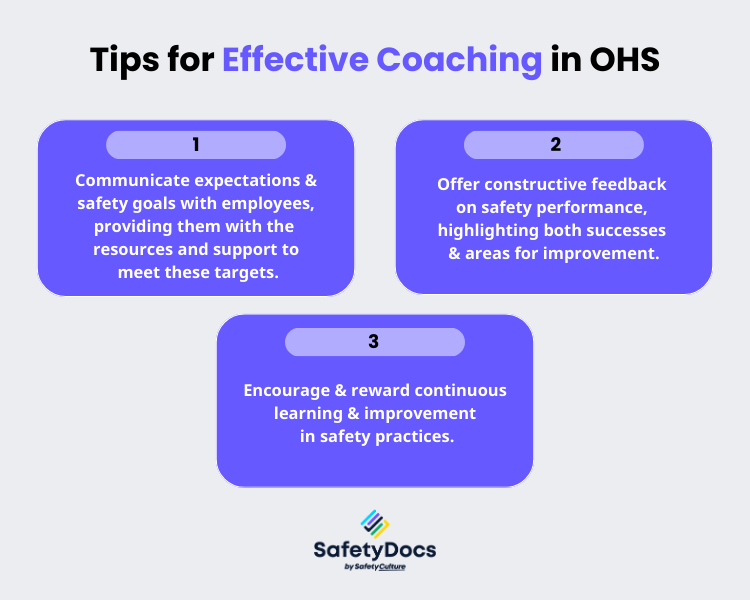The Australian Work Health and Safety Strategy 2023-2033 highlights the critical role of safety leadership in the workplace, identifying it as a key component in fostering safe and healthy work environments. Effective OHS leadership sets the tone and expectations for everyone within the organisation. In this article, we will delve deeper into the concept of OHS leadership and discuss key traits that leaders must have to promote a positive and proactive safety culture.
What Is Occupational Health and Safety Leadership?
Leadership in Occupational Health and Safety (OHS) refers to the role of individuals at various levels of an organisation who actively champion, influence, and execute practices and policies to ensure the safety, health, and well-being of all employees in the workplace. It goes beyond mere compliance with legal requirements; it fosters a culture where safety is ingrained as a core value and is considered everyone's responsibility, from top management to the front-line workers.
Cost of Poor Leadership
Poor Occupational Health and Safety (OHS) practices can have profound implications for the immediate well-being of employees and the long-term success and sustainability of an organisation. The costs of inadequate OHS measures can be categorised into three main areas:
Human Costs
Insufficient OHS management has the most direct and significant effect on human health and life. Data from the Australian Bureau of Statistics (ABS) reveals that, in the 2021-22 financial year, 497,300 individuals suffered from work-related injury or illnesses. This represents roughly 3.5% of the workforce employed during the year. The costs of neglecting OHS are multifaceted, impacting not just the bottom line but the very fabric that holds an organisation together – its people.
- Injuries and Fatalities: The most immediate and distressing cost comes in the form of work-related injuries and fatalities. This can range from minor injuries to severe, life-altering disabilities and deaths.
- Physical Health: Workers can suffer from various physical health issues due to poor OHS, including musculoskeletal disorders, respiratory conditions, hearing loss, and chronic ailments due to exposure to hazardous substances.
- Mental Health: The psychological impact of unsafe working conditions can be significant, leading to stress, burnout, anxiety, depression, and other mental health issues. This is exacerbated by the fear of accidents or the aftermath of witnessing or being involved in one.
Financial Costs
- Medical Expenses: Organisations may bear the direct costs of medical treatment, rehabilitation, and compensation claims for workers injured.
- Lost Productivity: Injuries and ill health result in absenteeism, while presenteeism (working while sick) can reduce productivity and performance. Losing skilled workers temporarily or permanently also disrupts operations and can delay projects.
- Increased Insurance Premiums: A poor safety record can lead to higher premiums for workers' compensation insurance, as insurers adjust rates based on an organisation's risk and claim history.
- Legal and Compliance Costs: Fines, penalties, and legal fees can accumulate if an organisation is found to violate OHS regulations. There are also costs associated with regulatory compliance and audits.
Reputational Costs
- Loss of Trust: Employees may lose trust in their employer's commitment to their well-being, affecting morale and engagement.
- Public Image: News of accidents, legal violations, or unsafe practices can damage a company's image. It affects customer perceptions and potentially leads to boycotts or loss of business.
- Investor Relations: Investors are increasingly considering social and governance factors, including how businesses manage worker safety. Poor OHS performance may make an organisation less attractive to investors.
- Recruitment and Retention: A reputation for poor safety can make attracting and retaining talent difficult, especially in industries where skilled workers are in high demand.

Key Traits of Effective OHS Leaders
While each organisation and industry may have unique needs, safety leaders should possess certain core traits that are essential in creating and maintaining a safe workplace. Aligned with the leadership principles mentioned by SafeWork Australia, here are key traits that leaders must have to cultivate a strong safety culture:
Proactive
Being proactive means anticipating rather than reacting to potential hazards. Effective safety leaders anticipate and identify risks, then take appropriate measures to mitigate them before they become accidents. This involves awareness and keeping abreast of the latest industry standards, technologies, and practices in health and safety management.
A proactive approach involves thorough risk assessments, regular audits, and proactive communication with employees about safety expectations. To cultivate a proactive mindset, safety leaders must foster a culture where employees feel comfortable reporting hazards, near-misses, and potential risks without fear of reprisal.
Collaborative
Collaboration is at the heart of successful safety leadership. Collaborative leaders actively seek the input and involvement of employees at all levels, from frontline workers to top management, in safety discussions and decision-making processes. They foster a team-oriented environment where everyone feels responsible for safety. This collaborative trait is particularly critical in industries with high-risk operations, where every employee's contribution to safety counts.
Data-Driven
Data is a powerful tool for identifying hazards, tracking safety performance and making informed decisions. Suppose safety leaders and management do not have access to accurate and timely safety data. In that case, they cannot effectively monitor or improve OHS performance.
Effective safety leaders invest in systems that capture, analyse, and report on safety data to track leading indicators (e.g., hazard reports) and lagging indicators (e.g., injury rates). A data-driven OHS leader bases decisions on solid data, not assumptions or guesswork.
Committed to Continual Improvement
Safety leaders must have a growth mindset and value innovation while continually seeking ways to enhance safety culture, processes, and systems. Continual improvement requires OHS leaders to monitor and evaluate safety performance, identify areas for improvement, set targets, track progress and take action.
To foster a culture of continual improvement, effective safety leaders involve employees in identifying opportunities for change and encourage open communication about OHS concerns. They also prioritise learning from incidents and near-misses to prevent future occurrences.
Systems Thinker
Systems thinkers understand the intricate interplay between various components of the Health, Safety, Environment, and Quality (HSEQ) management system. They recognise that effective safety management is not about isolated actions but involves an integrated approach. They see the bigger picture. They ensure that safety practices are integrated into every aspect of organisational operations. This systems-thinking approach enables them to create cohesive and efficient safety frameworks.
For example, a systems thinker may understand that investing in ergonomic workstations and regular breaks can improve worker health, reduce fatigue, and thereby enhance safety performance.
Technically Competent
A strong grasp of health and safety regulations and technical expertise is essential for OHS leaders to fulfil their duties effectively. Imagine leading a team of engineers and workers in a high-risk environment with little technical knowledge of the hazards present. Technical competence allows OHS leaders to understand risks and decide about safety measures, equipment selection, training needs, and emergency response plans. Effective safety leaders invest in their professional development by attending conferences, workshops, webinars, and training courses to continually enhance their knowledge and skills.
Why Good Safety Leadership Matters
Legal Compliance
If an organisation has good OHS leadership, it is more likely to comply with safety laws and regulations. In a workplace with effective safety leadership, employees are more likely to follow safe work practices, procedures, and policies. This compliance not only keeps workers safe but also protects the organisation from legal penalties and reputational damage.
Employee Well-being and Trust
Good health and safety leadership instils a sense of trust among employees. They feel valued and cared for, which translates into a more dedicated and motivated workforce. This trust forms the bedrock of a positive organisational culture, driving efficiency and lowering absenteeism rates due to work-related injuries or illnesses.
Corporate Responsibility
When safety leaders prioritise worker safety, they demonstrate a commitment to corporate responsibility. This goes beyond mere compliance with laws and safety rules; it reflects an organisation's values and ethics. Additionally, companies that invest in good health and safety leadership are more likely to attract top talent and retain their employees.

Effective Leadership Styles for OHS Success
Having established the essential traits that define effective safety leadership, let's now explore the leadership styles that best facilitate success in OHS management.
1. Transformational Leadership
This style of leadership involves inspiring and motivating employees to go beyond their self-interests for the greater good of the organisation. Transformational leaders communicate a clear vision, create a supportive work environment, and foster innovation and growth. In terms of OHS management, these leaders actively engage employees in safety initiatives, encourage open communication, and empower them to take ownership of safety.
Leading by Example Tips:
- Attend Training With Employees: Show your commitment to safety by participating in safety training sessions alongside your team.
- Publicly Acknowledge Safe Behaviours: Recognise and reward employees who adhere to safety protocols, setting a visible standard for others to follow.
- Share Personal Safety Stories: Connect with your team by sharing your own experiences and lessons learned regarding workplace safety.
2. Democratic Leadership
Under this style, leaders involve employees in decision-making processes and delegate tasks based on individual strengths and capabilities. This participatory approach encourages employee engagement, ownership, and continuous improvement. In the context of OHS, democratic leaders encourage employees to report hazards and provide suggestions for safety enhancements.
Tips for Soliciting Feedback and Empowering Committees:
- Encourage open discussions about safety concerns and suggestions during team meetings or toolbox talks.
- Create safety committees that include employees from various levels to participate in safety planning and decision-making processes.
- Implement regular surveys to gather anonymous feedback on safety practices and potential improvements.
3. Coaching Leadership
Coaching leaders focus on developing and nurturing employees' skills, knowledge, and confidence levels to achieve their full potential. In the realm of OHS, this leadership style involves providing employees with regular feedback, training opportunities, and mentorship to improve safety performance. For example, a coaching team leader may provide one-on-one training on the proper use of personal protective equipment or conduct regular safety audits to identify areas for improvement.

Tips for Effective Coaching in OHS:
- Communicate clear expectations and safety goals with employees, providing them with the necessary resources and support to meet these targets.
- Offer constructive feedback on safety performance, highlighting both successes and areas for improvement.
- Encourage and reward continuous learning and improvement in safety practices.
4. Strategic Leadership
Strategic leaders emphasise the importance of using data, analysis, and foresight to guide decision-making processes. In the context of OHS, this style involves conducting thorough risk assessments, staying informed about changing safety regulations and industry standards and developing long-term safety plans. Strategic leaders also prioritise investing in the necessary resources such as:
- Technology: Leveraging advanced safety technologies, such as wearable devices, IoT sensors, and predictive analytics, can enhance hazard detection and enable proactive risk management.
- Training and Development: Investing in ongoing training programs equips employees with the skills and knowledge needed to identify hazards, respond to emergencies, and promote a culture of safety.
- Research and Development: Supporting research initiatives focused on safety innovation enables organisations to stay ahead of emerging risks.
- Collaborative Partnerships: Building alliances with industry associations, government agencies, and peer organisations.
5. Situational Leadership
Situational leaders adapt their leadership style based on the specific context, task, or safety challenge at hand. Example scenarios:
- During a Crisis: In an emergency or accident, leaders must act decisively, communicate clearly and provide the necessary support to ensure the safety of all employees.
- When Implementing Changes: When introducing new safety policies or procedures, leaders should be transparent about the reasons behind the change, gather employee feedback, and provide adequate training and support during the transition.
- Introducing New Safety Technologies: Use a coaching leadership style to guide employees through the adoption of new safety technologies. Explain the benefits, provide hands-on training, and offer ongoing support to ensure successful implementation.
- After Identifying a Pattern of Unsafe Behavior: Employ a transformational approach to inspire a shift in culture, emphasising the value of safety and leading by example to change behaviours.
Avoid the Laissez-Faire Trap
Laissez-faire leadership is a hands-off approach where leaders provide minimal direction and allow team members to make decisions and solve problems independently. This style can promote autonomy and creativity in the right contexts; however, in OHS, it poses significant risks.
The lack of oversight and guidance can lead to inconsistencies in safety practices, reduced compliance with regulations, and potentially higher rates of accidents and injuries. The absence of active leadership in OHS can result in a workplace culture that undervalues safety. A better approach involves leaders empowering their employees within a structured safety system.
Empower OHS Leadership with SafetyDocs
You may have the top traits and the appropriate style to be an effective safety leader. However, leaders must also have access to the necessary tools and resources to manage OHS effectively. It makes a difference when leaders have the right tools and resources to identify hazards, monitor safety performance and promote a culture of safety.
SafetyDocs by SafetyCulture offers a comprehensive suite of safety document solutions that empower organisations to improve their OHS performance through:
- Access to a library of pre-built safety templates, checklists, and forms.
- Safe Work Method Statement Templates: every industry, job/activity type is covered.
- Safety Management System Templates: ready-to-use documents that align with current regulatory requirements and industry best practices.
- Management Plans: to ensure all workers are equipped with the knowledge and skills for their jobs while complying with OHS laws.
- Customisation options for organisations to tailor their safety documents to their specific needs.
- Compliant documentation for various industries and regions.
- Collaboration tools to enable effective communication and reporting among safety teams.
Investing in safety document solutions can help your leadership team achieve their OHS goals. Achieve it all with SafetyDocs today!
Our team of experts is dedicated to providing accurate and informative content. Craig Cruickshank, our senior HSEQ advisor at SafetyDocs by SafetyCulture has reviewed this blog post to ensure the highest level of quality.
Learn more about Craig's work on LinkedIn for more industry insights.
Available for instant download and supplied in fully editable MS Word format for use in your business.
Please note that the above information is provided as a comment only and should not be relied on as professional, legal or financial advice.
Share This Article
